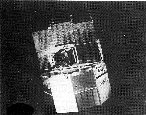|
|
OSO-7

The proportional counters and hard X-ray telescope on board OSO-7 scanned
the entire sky and obtained good exposure of point sources through repeated
scans.
Data from the proportional counters yielded a "multi-color"
catalog of 184 sources (Markert et al., 1979) and the detection from
Centaurus A of rapid intensity variability (Winkler & White,
1975). The X-ray telescope studied the high energy temporal and
spectral behavior of a number of sources including Her X-1 (Ulmer er
al., 1973) and Vela X-1 (Ulmer et al., 1972).
Just under three years of data on celestial X-ray sources were obtained
using the MIT instrumentation aboard the OSO-7 satellite. The detection
system consisted of two banks of proportional counters which viewed the
sky through 1- and 3-deg tubular collimators (FWHM) and covered a 1 to
60-keV energy range in five broad energy intervals (1-1.5 keV; 1-6 keV;
3-10 keV; 15-40 keV; 30-60 keV). The data were recorded in 256 azimuthal
bins as the detector scanned across a small circle on the sky with each
spin. The time resolution was 3.2 minutes.
The UCSD OSO-7 X-ray telescope was designed to detect X-rays in the
range from about 7 to 550 keV. It consisted of a 1 cm thick NaI(Tl)
crystal inside a massive CsI(Na) anticoincidence shield. There were 128
energy loss channels. Each event signature also contained a clock time
good to 0.625 ms. The field of view was 6.5 degrees FWHM and the sensitive
area was ~ 64 sq-cm. The total detector weight was 85 lbs.
The UNH gamma-ray monitor consisted of a 7.6 cm x 7.6 cm NaI(Tl)
scintillator which operated in the range 300 keV - 10 MeV. The detector was
surrounded on all sides by a ~ 4 cm thick CsI(Na) scintillator cup. The
exception was a forward aperture which was covered by a 0.5 cm thick
CsI(Na) slab. The instrument was calibrated regularly each orbit with a 60Co
source. The resolution was 7.8% at 662 keV. The instrument was in the wheel
section of OSO-7. Data were accumulated in 0.5 s bins when the detector was
looking at the Sun/anti-Sun during each 2-s spin. The monitor operated until
25 December 1972, but was usually turned off during the periodic penetration
of the satellite into the radiation belts.
A sky map of the X-ray intensity was derived directly from several hundred
days of data from the MIT experiment. The same experiment also produced
results for three important compact galactic sources: Sco X-1,
Her X-1 and Cyg X-1, as well as results of observations of the supernova
remnant IC 443, supernova 1972e, and a unique flare source, GX 354+3.
The UCSD experiment produced results on Cyg X-3 which showed the 4.8-hr
period present in the 6-21 keV range, but not in the 21-98 keV range.
[OSO-7 Home]
[About OSO-7]
[Gallery]
[Publications]
Page authors: Lorella Angelini Jesse Allen
HEASARC Home |
Observatories |
Archive |
Calibration |
Software |
Tools |
Students/Teachers/Public
Last modified: Tuesday, 03-Nov-2009 18:48:23 EST
|


